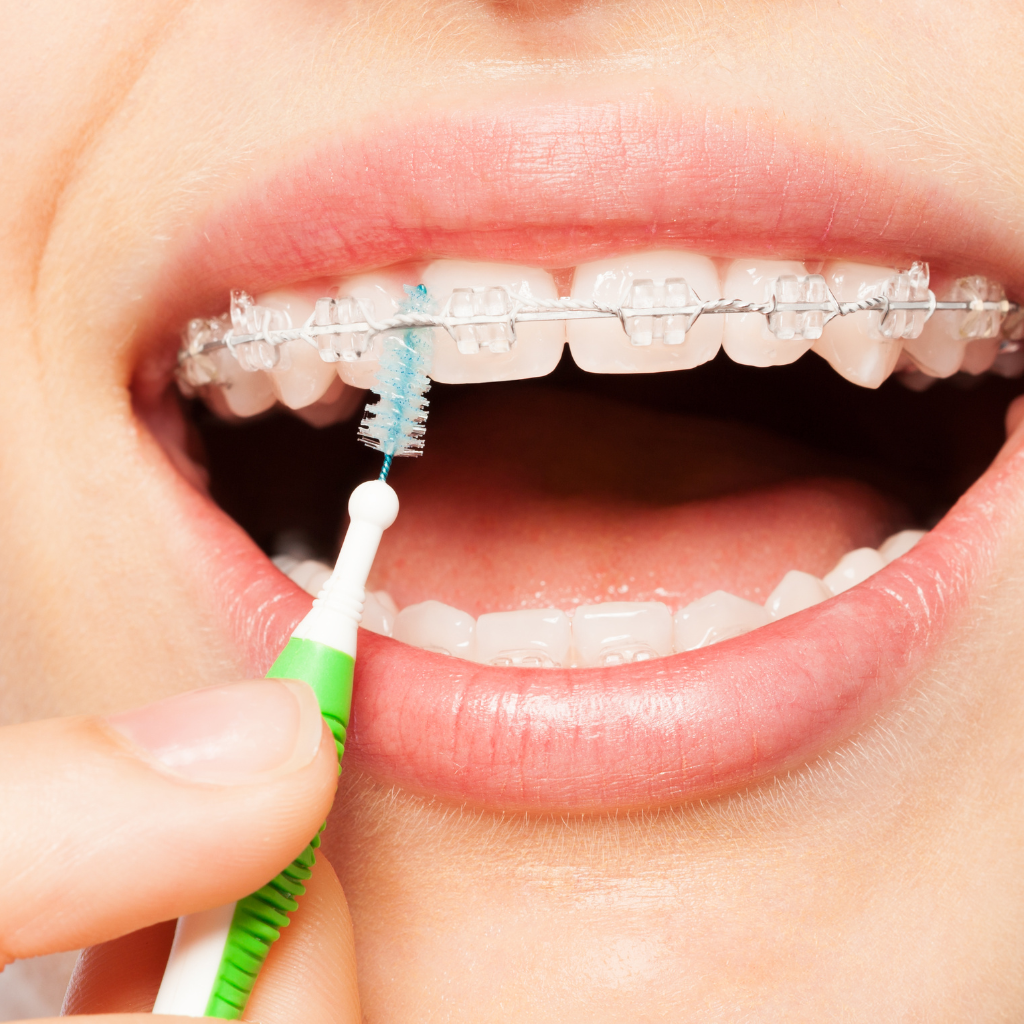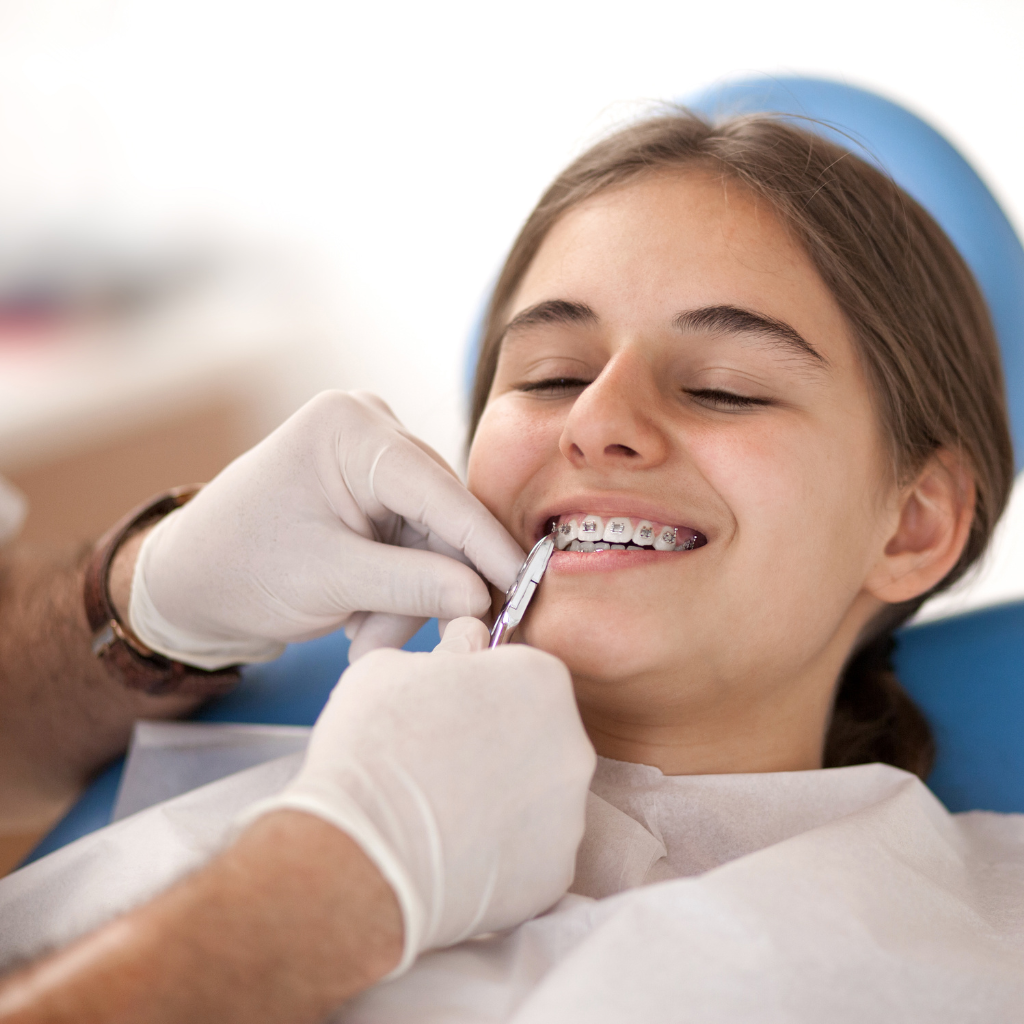Maintaining braces requires a meticulous oral hygiene routine, including using a soft-bristled toothbrush to clean around brackets and employing a floss threader for interdental cleaning. Patients should avoid hard and sticky foods to protect the structural integrity of braces and attend regular dental checkups for adjustments and monitoring. Staying committed to these practices guarantees both effective treatment and ideal oral health. Discover more about the different types of braces and specific care strategies by exploring them further.
Key Takeaways
- Brush teeth using a soft-bristled toothbrush at a 45-degree angle to clean around brackets and under wires effectively.
- Floss daily with a floss threader is used to remove food particles and plaque from between teeth and braces.
- Avoid hard, crunchy, and sticky foods to prevent damage to braces and ease cleaning efforts.
- Schedule regular dental checkups to adjust braces and monitor oral health progress.
- Use orthodontic wax to manage irritation and protect gums from sharp brace edges.
How to Care for Braces: What You Need to Know
Maintaining ideal oral hygiene with braces involves specific techniques and healthy habits.
It is essential to understand the most effective methods for brushing teeth with braces and to recognize the importance of regular flossing.
Additionally, comprehending why maintaining excellent oral hygiene is particularly vital for those wearing braces will help prevent common dental issues associated with orthodontic treatments.
What Is the Best Way to Brush Your Teeth with Braces
Proper tooth brushing with braces is essential for preventing oral health issues such as plaque buildup and gum disease. With teeth braces, brushing techniques must be adapted to clean around brackets and wires properly. Using fluoride toothpaste, individuals should focus on maintaining rigorous oral hygiene to combat the challenges of food debris trapped by braces.
- Use a Soft-Bristled Brush: Opt for a toothbrush with a flat brushing surface and soft bristles to gently clean teeth and braces without damaging the brackets.
- Brush at a 45-degree Angle: Position the brush at an angle to better reach under the wires and around the brackets, ensuring thorough removal of plaque and food particles.
- Implement Detailed Brushing and Flossing Routine: Dedicate more time to brushing and carefully use dental floss to remove any remaining debris around the braces.

How Often Should You Floss While Wearing Braces
While detailed brushing is a crucial part of oral hygiene for those with braces, flossing should not be overlooked. Those with dental braces should floss their teeth at least once daily to maintain good oral hygiene.
Using a floss threader facilitates the process, allowing the floss to navigate effectively around the braces, helping to clean between your teeth where sticky foods may lodge. Regular flossing is integral to any braces care routine, greatly reducing the risk of cavities and gum problems.
Additionally, incorporating regular dental checkups guarantees that any potential issues are addressed promptly during orthodontic treatment. Adhering to this regimen not only protects the health of teeth with braces but also optimizes the effectiveness of the treatment.
Why Is Oral Hygiene Crucial for Braces Wearers
Guaranteeing ideal oral hygiene is vital for individuals wearing braces, as it directly impacts the success and efficiency of the orthodontic treatment. Maintaining rigorous dental care routines helps to prevent common issues that can complicate or extend the duration of wearing braces.
- Preventing Plaque Build-up: Brace wearers are more susceptible to plaque accumulation, as brackets and wires can trap food particles. Regular brushing and flossing with braces are fundamental to remove these particles and prevent plaque formation.
- Avoiding Tooth Decay and Cavities: Inadequate oral hygiene can lead to tooth decay and cavities under or around the braces, potentially leading to additional dental treatments.
- Keeping Gums Healthy: Effective oral hygiene practices protect your braces and guarantee gums remain healthy, reducing the risk of gum diseases exacerbated by trapped food and bacteria.
Brushing and Flossing: Keys to Good Oral Hygiene
Maintaining ideal oral hygiene with braces requires adjustments to both brushing and flossing techniques.
Specialized tools such as orthodontic toothbrushes and floss threaders are essential for effectively cleaning around brackets and wires in the same way that traditional tools are used.
This section explores how these adjustments and tools are necessary to prevent plaque buildup and guarantee dental health throughout orthodontic treatment.
How Do Braces Affect Your Brushing Routine
When individuals wear braces, their approach to maintaining dental health and making teeth easier to clean must adapt markedly.
Braces, as complex orthodontic appliances, create numerous tiny spaces where food particles can easily become trapped. This necessitates a more meticulous and specific brushing routine to prevent decay and guarantee the health of teeth and gums.
- Increased brushing frequency: It’s crucial to brush after every meal or snack to remove food debris and prevent plaque buildup around the brackets.
- Use of specialized oral health products: Employing orthodontic toothbrushes or brush heads designed for braces can enhance cleaning effectiveness.
- Careful selection of foods: Consuming mainly soft foods reduces the risk of damaging the braces and makes cleaning easier.

What Tools Can Help in Flossing with Braces
While brushing frequently and using specialized tools are important for those with braces, flossing should not be overlooked as it plays a significant role in maintaining oral hygiene.
For individuals with braces, traditional flossing can be challenging due to the wires and brackets. However, using tools like floss threaders or orthodontic flossers can facilitate this process, helping to prevent dental problems and ensuring the care of your braces.
Oral irrigators, also known as water flossers, provide an effective alternative by using a stream of pulsating water is used to eliminate plaque and food particles.
Consulting with a dentist or orthodontist about the best flossing practices is essential for practising good oral hygiene and maintaining a healthy smile.
Maintaining a Healthy Smile with Orthodontic Treatment
Maintaining a healthy smile with orthodontic treatment extends beyond regular brushing and flossing, particularly when it comes to diet and physical activity.
Patients should be cautious about consuming foods that can damage braces, such as hard candies and popcorn, to prevent any disruptions in treatment. For those considering alternatives, there are methods to straighten teeth without braces, but it’s essential to weigh the pros and cons of each option.
Additionally, wearing a mouthguard during sports activities requires special attention to protect both the braces and the integrity of the orthodontic work.
What Foods Should Be Avoided with Braces
When undergoing orthodontic treatment, certain dietary adjustments are essential to guarantee that braces remain functional and intact.
Eating with braces requires extra care to protect teeth and gums from discomfort or damage. Certain foods can stick to the braces, increasing the risk of harm and complicating oral hygiene efforts.
Here are specific foods to avoid:
- Crunchy foods: Hard items such as popcorn, nuts, and hard candies can break or dislodge the wires and brackets of braces.
- Sticky foods: Chewy candies, gum, and caramel can stick to braces, making them difficult to clean and may lead to tooth decay.
- Hard fruits and vegetables: Raw carrots, apples, and similar produce should be cut into small pieces to reduce the risk to teeth and braces.
How to Protect Your Braces During Sports
Engaging in sports activities presents a unique set of challenges for individuals with braces, necessitating specific protective measures to prevent injuries to the mouth and damage to the orthodontic devices.
To protect your braces and teeth, wearing a mouthguard is vital. This simple device can shield against external damage and minimize the risk of braces breakage during physical contact.
Athletes with braces should give extra attention to the type of mouthguard used; opting for an orthodontic mouthguard designed to fit over braces is advisable.
These precautions and tips are important for maintaining orthodontic care integrity. Overall, sports with braces require special care and attention to guarantee both safety and the ongoing effectiveness of the orthodontic treatment.
Common Issues with Braces and How to Address Them
While braces are effective for correcting dental alignment, they can also cause discomfort and technical issues.
Patients often experience soreness following adjustments. This can usually be managed with over-the-counter pain relievers and oral gels.
Additionally, broken brackets and irritation to the gums and inner mouth are common concerns that require timely intervention and proper care techniques to prevent further complications.
Dealing with Soreness After Adjustments
Adjusting braces often results in temporary soreness, a common issue for many patients. This discomfort is a natural part of the braces treatment process, often caused by the necessary adjustments that guarantee your braces effectively realign your teeth.
To alleviate this pain and help your teeth and gums stay healthy, consider the following care tips:
- Use over-the-counter pain relievers: Follow your dentist’s recommendations for pain relief medications to reduce inflammation and ease discomfort.
- Apply oral anaesthetics: Gels or sprays can be applied directly to the gums and teeth to numb sore areas temporarily.
- Maintain a soft food diet: Immediately after adjustments, consume soft foods that require minimal chewing to lessen the strain on your teeth and gums.
How to Handle Broken Brackets
Broken brackets are a common complication for those wearing braces and can occur from eating hard foods, an accident, or simply the strain of teeth shifting.
When a bracket breaks, it is vital to take immediate action to prevent further damage to your teeth and the orthodontic device. Contact your dental clinic promptly to schedule a repair.
In the interim, use orthodontic wax to cover any sharp edges that could irritate your mouth. Avoid further stressing the braces by steering clear of hard or sticky foods.
Continue to brush your teeth after every meal using techniques and tools recommended for use with braces to maintain oral hygiene.
Managing Irritation from Braces on Your Gums and Mouth
Irritation of the gums and mouth is a frequent issue for individuals with braces, often resulting from the constant friction between the braces and soft tissues.
To manage this discomfort effectively and maintain the care of your teeth, consider the following strategies:
- Use Orthodontic Wax: Apply dental wax to the brackets and wires that are irritating. This acts as a barrier, protecting your gums and the inside of your mouth.
- Maintain Oral Hygiene: Regularly clean your teeth and braces. Use a soft-bristled toothbrush and fluoride toothpaste to remove debris and reduce the risk of irritation gently.
- Diet Adjustments: Incorporate soft fruits and cooked vegetables into your diet. These are easier on your teeth while wearing braces and help prevent additional stress on irritated areas.
Understanding the Role of Your Orthodontist in Braces Care
In managing orthodontic treatment, regular dental checkups play a critical role in ensuring the effectiveness and safety of braces. During these appointments, the orthodontist assesses the progress of tooth alignment and makes necessary adjustments to wires and brackets to advance treatment goals. It’s also important to note that the average age for braces can vary, but typically, many patients start treatment between the ages of 10 and 14. This proactive approach not only facilitates ideal dental health but also aligns with achieving timely and successful orthodontic outcomes.

Why Are Regular Dental Checkups Important
Regular dental checkups play an essential role in the maintenance of braces, as they allow the orthodontist to monitor the progress of the teeth’s alignment and make necessary adjustments.
These visits are vital for guaranteeing the teeth and braces are maintained properly, preventing potential dental issues that could arise from improperly aligned braces.
- Early Detection of Problems: Regular monitoring helps catch and address any emerging dental issues before they worsen.
- Adjustment and Maintenance: Guarantees braces are adjusted correctly and functioning as intended, which is important to take the best care of your braces and keep your braces in good condition.
- Guidance on Oral Hygiene: Orthodontists provide personalized advice on how to take care of your braces and keep their teeth in good health, emphasizing the need to clean teeth after every meal.
How Can Your Orthodontist Help in Adjusting Wires and Brackets
An orthodontist plays an important role in the care of braces, particularly in adjusting wires and brackets to guarantee effective tooth movement. These adjustments are fundamental for both traditional braces and lingual braces, as they gradually align the teeth, making the process of wearing braces more efficient and comfortable.
| Type of Braces | Adjustment Purpose | Benefits |
|---|---|---|
| Traditional | Align teeth | Improved bite alignment |
| Lingual | Enhance comfort | Less visible treatment |
| Both | Facilitate cleaning | Easier teeth maintenance |
Regular visits allow the orthodontist to monitor progress and make timely adjustments, which is essential for the success of the treatment and overall dental health.
Exploring Different Types of Braces and Their Care
As orthodontic technology advances, there are more options available, including several types of braces that have emerged, each requiring specific care routines.
Lingual braces, positioned behind the teeth, pose unique challenges in cleaning due to their placement.
Conversely, clear aligners offer a different maintenance regimen, often being removable, which impacts their cleaning process.
The care needs of adults using braces may vary due to differing oral health conditions and lifestyle factors.
What Are the Unique Challenges of Lingual Braces
While traditional braces are visible and attach to the front of the teeth, lingual braces present a unique set of challenges due to their position behind the teeth.
These challenges require specialized knowledge on how to care for braces, guaranteeing they function properly and comfortably. Here are some key points to take into account:
- Tongue irritation: Since the brackets face the tongue, irritation is more common, necessitating tips for caring that reduce discomfort and prevent sores.
- Difficulty cleaning: The hidden position makes cleaning more challenging with braces, requiring more meticulous techniques and tools to maintain oral hygiene.
- Speech difficulty: Initially, lingual braces can affect the bite and speech, requiring patience and possibly speech therapy exercises to adjust fully.
How Do Clear Aligners Differ in Maintenance
Moving from the intricacies of lingual braces, clear aligners offer a distinct approach to orthodontic treatment that demands a different maintenance regimen.
Unlike traditional braces often seen in a child’s mouth, clear aligners are removable and, therefore, require patients to be careful when they eat. Essential tips for maintenance include removing the aligners before meals to prevent damage and staining.
It’s vital to clean both the aligners and teeth regularly to keep your teeth healthy. Adults and children alike must learn how to take care of their aligners, designed specifically for braces, by rinsing them under water and using a soft-bristled brush.
Such careful upkeep guarantees the effectiveness of the treatment and maintains oral hygiene.
Are Adult Braces Different in Care Needs
Do adult braces require different care compared to those typically recommended for younger individuals. Fundamentally, the maintenance of adult braces aligns closely with the protocols set for younger wearers.
Adult patients must follow the same stringent hygiene practices to guarantee peak dental health. Here’s everything you need to know:
- Hygiene Practices: Maintaining normal cleaning routines is vital when you have braces to prevent various dental issues.
- Dietary Adjustments: Just as with younger individuals, adults should avoid hard and sticky foods that can damage braces.
- Regular Checkups: Consistent visits to the orthodontist are necessary to adjust the braces and monitor progress.
These care strategies guarantee that adult braces may function effectively, preserving both aesthetics and dental health.
Conclusion
In summary, maintaining braces requires diligent care and an understanding of the specific needs associated with different types of orthodontic devices. Regular brushing, flossing, and following the guidance of an orthodontist are essential for ensuring the health of both teeth and braces. Addressing common issues promptly and adhering to professional advice can lead to a successful treatment outcome. Ultimately, the effort invested in caring for braces greatly contributes to achieving a healthy, beautiful smile.


